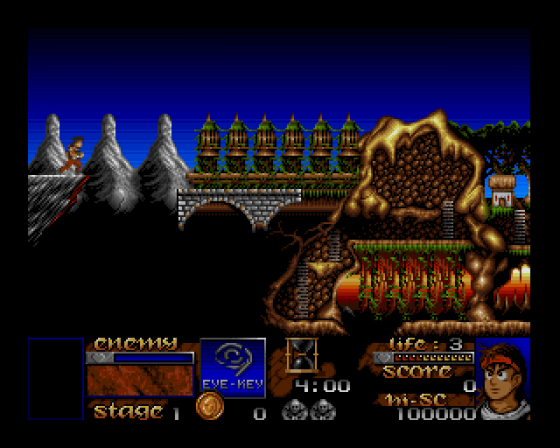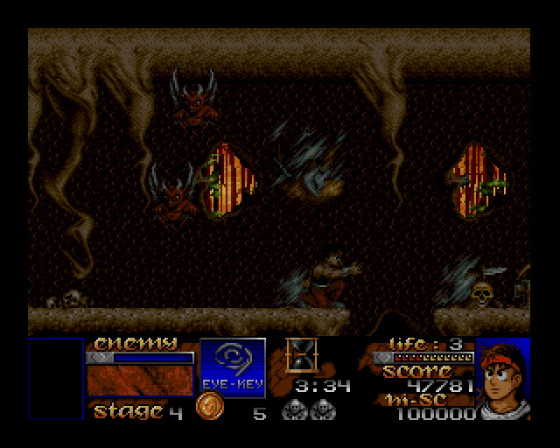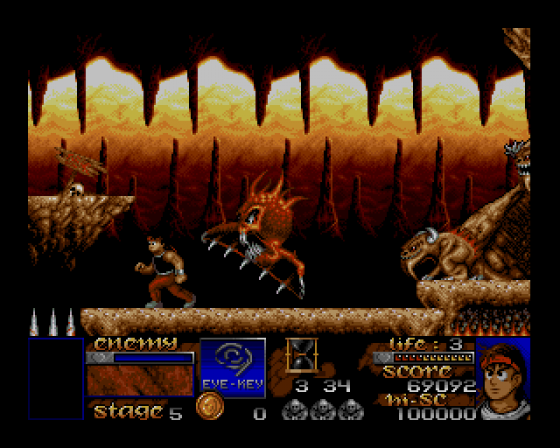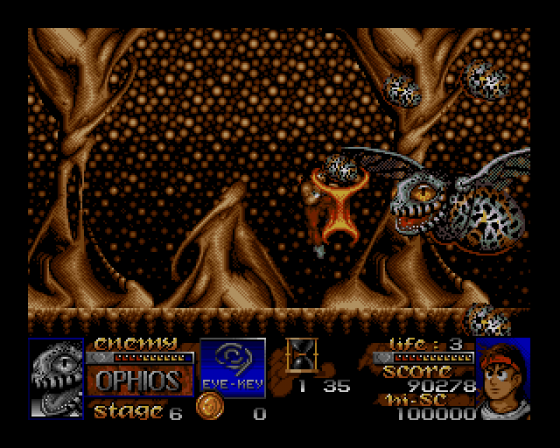
Amiga Power
 1st July 1992
1st July 1992
Categories: Review: Software
Author: Matthew Squires
Publisher: Electronic Arts
Machine: Amiga 500
Published in Amiga Power #15
With Risky Woods, even Electronic Arts are muscling in on the console-style beat-'em-up, with this lush looking epic - from Spain of all places!
Risky Woods
I can just imagine how this one came together. Somewhere in Europe in the not-too-distant past, a Spanish development team (for Zeus Software, who originally developed this for Madrid-based Dinamic, are Spanish) decided to sit down over a meal to discuss this brand new game they were putting together. But - oh no! - they decided to try this new restaurant in town, a sushi bar, and somehow the Japanese influence got lodged in their minds, and grew and grew.
They must have been back to that old sushi bar quite a few times during development too, for the over-hard-yet-graphically-impressive style of game that Spanish developers used to specialise in (Remember Dinamic's older stuff, like Army Moves, Navy Moves and After The War?) has been all but dropped in favour of one of those wannabe Mega Drive games that seem to be all the rage at the moment. There's lots of very similar competition around at the moment, so what chance does Risky Woods stand?
Well, for a start it's got just about all the standard features of the genre. It's got pretty, big-eyed graphics, crowd pleasing parallax scrolling, lots of collectables, and big end-of-level baddies, all wrapped up behind a suitably odd (and rather silly) name. Because it's such a typical console-style game, there are half a dozen other recent releases we could legitimately compare it too, but I've picked Psygnosis' recent Leander - the current Amiga Power benchmark for "this sort of thing".
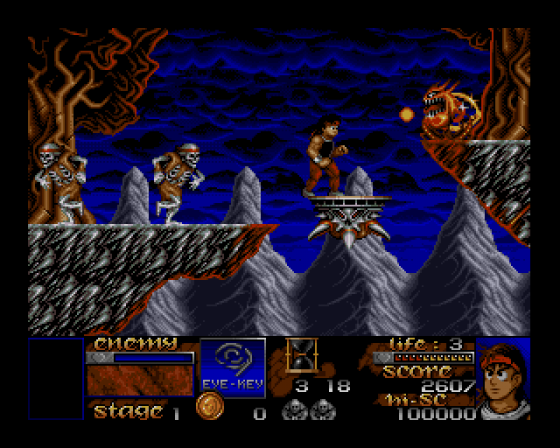
On initial impressions there's not really much to choose between the two games. Both of them have a very slick feel, with smooth scrolling and big sprites - at first it all comes down to which graphics style you prefer. In the interests of creating a bit of tension, I'm not going to tell you if things change after you've played both games for a while - not just yet anyway. Instead, let's take a closer look at the ins and outs of the game they're all calling Risky Woods.
The story of Risky Woods (I keep writing to write 'Wisky Woods') takes place in a Japan-esque 'Lost Land' in a time when an order or monks guarded the place. Or, at least, they used to guard it - until a wicked demon character called Draxos came along and turned them all to stone! Evil has taken over pretty much, then, with vicious creatures everywhere, and rotting animated skeletons roaming the woods, making them rather (ahem) 'risky'. The kingdom is not safe until you, in the guise of a young warrior called Rohan, arrive on the scene.
Right, so, as you may have guessed by now, it's up to you to enter the Risky Woods, free the monks from Draxos' stoney spells and send the evil tyrant back to hell (or wherever it was he came from). It's the classic Japanese fairytale, if you like, where the young samurai-type comes along, helps out the wise men, and banishes evil.
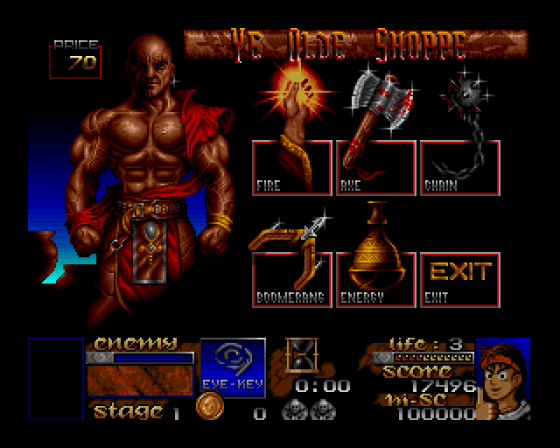
The game is built up of twelve stages - with a more or less continuous flow of evil demons in all shapes and sizes out to stop you, and in a big end-of-zone guardian cropping up every few levels. You're given three lives to help you out - but keep an eye on the time limit for each level, and the set number of monks you must free on each one. Throughout the game, enemy demons drop coins when you kill them - these you can use to buy weapons, strength and extra lives at the shop, which you'll find at the end of each stage.
Other important items to look out for are the halves of 'eye keys' that occasionally crop up, guarded by jealous guardian demons. Kill the guardians, then put the two pieces together to form the completed eye key - you can now use these at 'eye toll gates', which control entry through each stage. You'd better make sure you collect all the eye halves you find as you come to them too - they're the only way off a level, and (unlike in Leander) there's no going back more than a couple of screens to collect stuff you missed. Another thing to be on the look out for treasure chests. Open them up wherever they appear - they throw out all sorts of goodies, but be careful not to pick up certain items which can hinder as well as help you!
As the game advances, the terrain and obstacles in your way get more difficult to deal with. Take, for example, the narrow stepping posts you must jump across at the end of the first stage. A giant blade rears up between them to make life even more difficult for you, while demons fly in from either side. And individual obstacles can get tougher than that too...!

The only other major game elements to deal with are the guardian monsters, which live in caves between each zone. Their strength gets greater the further into the game you get, so make sure you increase the power of your weaponry at the shop. (You're unlikely to get very far if you don't.) You'll find the shop very easy to use, simply by selecting the appropriate icons.
And that, in a nutshell, is the game. So how does it shape up against all the other console-inspired platformers, particularly (if you remember that far back) Leander? Well, on its own terms you can't deny it's lots of fun - so much so that you're likely to bash through it in a few days, not so much because it's particularly small, but simply because you'll be going at it so much.
That said though, there are a few specific and important niggles. The controls, while okay, are still a fair way from spot on - our hero is rather more plodding than I would like (though not as bad as the bloke in Gods, thank goodness!) while his jumping ability sometimes feels pathetically weedy.
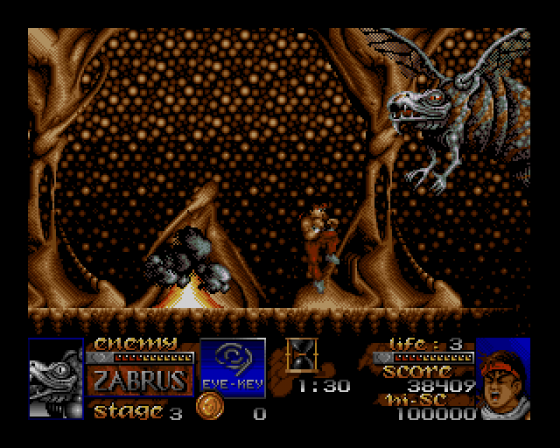
I wish you were given a bit more freedom of movement too - the very best platform games are less linear than this, and particularly when success depends so much upon collecting the eye keys you'd think being able to search behind you would be essential.
Still, it's not a bad buy at all. I found the first seven levels absorbing and entertaining, the hectic sound effects, frenzied animation, and pretty graphics making for an atmospheric experience. That said, the later stages - when you realise that really nothing changes from level to level, save for the graphics - begin to get a bit dull (a problem also suffered by Leander, if we're being fair). Great to look at, then, and good short term fun, and while it's probably on a par with Leander et al, it's certainly no better than them. Out favourite of the type remains First Samurai (where you get a lot more freedom of movement) but you could do a lot worse than this.
The Bottom Line
Uppers: Tasty elements of the very best console-esque platform action are abundant in Risky Woods. The graphics, animation and sound are presented fairly expertly too, while a couple of interesting touches (the 'bad' power ups, for instance) keep you interested.
Downers: Restrictive one-way scrolling, non-perfect controllability, and shallow gameplay do let the game down. There are some novel graphic innovations, but there's also a lot we've seen before.
Lacking variation and depth, Risky Woods does compensate with plenty of frenzied, and atmospheric platform action. It's a good buy for fans of the genre, but by no means a must.
Other Reviews Of Risky Woods For The Amiga 500
Risky Woods (Electronic Arts)
A review



